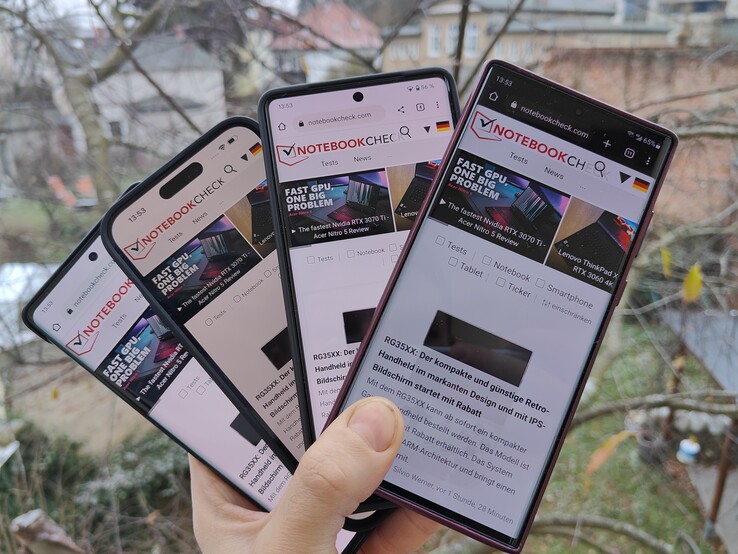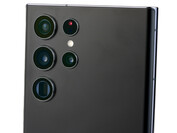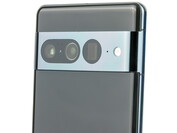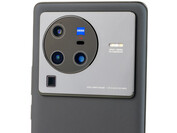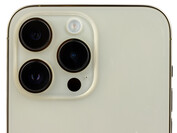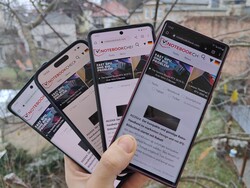The best phone cameras in early 2023 - A comparison
After having examined flagship smartphones' camera quality at the beginning of last year, we've now taken a good look at today's smartphone elite with the greatest potential to have the best camera on the market. Due to its limited availability, we decided not to include the Xiaomi 12S Ultra, although its large Sony IMX989 and excellent image quality would have made it an ideal candidate for this comparison.
Instead, we will be looking at the iPhone 14 Pro Max, the Pixel 7 Pro, the Vivo X80 Pro and the Galaxy S22 Ultra. We used a Samsung flagship with Qualcomm Snapdragon 8 Gen.1 for our pictures. We were able to determine certain quality differences in the camera between this version and the European version with the in-house Exynos 2200, but as the differences are minor, our results are still valid for the Exynos version as well.
All smartphones are quite similarly priced. Only the Pixel 7 Pro starts out with a recommended price below 1,000 Euros. All devices were up to date at the time of testing and were tested via their integrated camera apps with AI support turned on.
| Samsung Galaxy S22 Ultra | Google Pixel 7 Pro | Vivo X80 Pro | Apple iPhone 14 Pro Max | |
|---|---|---|---|---|
| Camera setup: back | 108 MPix (f/1.8, 1/1.33, OIS) | 50 MPix (f/1.85, 1/1.31", OIS) | 50 MPix (f/1.6, 1/1.3", OIS) | 48 MPix (f/1.78, 1/1.28", IOS) |
| Telephoto lense(s) | + 10 MPix (f/2.4, 1/3.52", OIS) + 10 MPix (f/4.9, OIS) | + 48 MPix ( f/3.5, 1/2", OIS) | + 12 MPix (f/1.9, 1/2.93", OIS) + 8 MPix (f/3.4, 1/4.4", OIS) | + 12 MPix (f/1.78,) |
| Ultra wide angle lense | + 12 MPix (f/2.2, 1/2.55") | + 12 MPix (f/2.2) | + 48 MPix (f/2.2, 1/2.0") | + 12 MPix (f/2.8) |
| Camera setup: front | 40 MPix (f/2.2, 1/2.82") | 10.8 MPix (f/2.2) | 32 MPix (f/2.5, 1/2.8") | 12 MPix (f/1.9) |
| Software version | S9080ZCU2BVL1 | TQ1A.221205.011 | 13.1.10.18.W30 | 16.2 |
High-resolution main cameras have been a standard component of high-end Android smartphones for many years and are becoming more common for Apple phones as well. What surely passes for old hat for Android users is uncharted territory for Apple users: pixel binning. Th process involves computationally enlarging the actual length of individual pixels in order to capture more light and image details. All smartphone cameras in this comparison use pixel binning, which means that the resolution of the photos generally doesn't equate to the camera sensor's resolution. All four smartphones also use algorithms to automatically get the most out of every photo. Except for the portrait photos, all pictures were taken in photo mode (the Vivo X80 Pro's Zeiss mode is not activated ex-works).
comparison of flagship smartphones' main cameras
The main camera of our flagship smartphones
Let us begin with the most important aspect of a smartphone: its main camera. Our test samples all perform well or even very well, albeit with surprisingly visible differences in image sharpness in very good lighting.
The Samsung Galaxy S22 Ultra provides the most sharpness when photographing objects that are close up, while the Pixel 7 Pro has visible deficits. Although the Korean Galaxy smartphone adds a little too much sharpness at times, the Google flagship often produces blurred pictures, particularly along the outer edges. Similarly, the Vivo X80 Pro blurs the content of our photos, although we prefer the look of the pictures it produces in general. This also goes for the iPhone 14 Pro Max, although the Apple flagship doesn't do particularly well in terms of sharpness and white balance.
The Samsung phone also creates the most appealing Bokeh effects. Even with a comparably simple subject such as our garden gnomes, the Pixel 7 Pro makes unexpectedly serious errors in the delineation of the blurred areas. The X80 Pro's picture is not as sharp as the ones taken with the iPhone 14 Pro Max, let alone the Galaxy S22 Ultra. The Google flagship makes up ground when photographing houses, with plenty of details and realistic colors that resemble the picture taken with the iPhone 14 Pro Max (although the Apple flagship doesn't display fine structures in quite the same detail). This is where the Vivo X80 Pro shines, while its color reproduction is too cool and the picture has been overly brightened. Samsung's Galaxy S22 Ultra can't quite reproduce the natural coloring of the image's subject either.
All test candidates reveal massive weaknesses in the dark. We were most pleased with the photos taken with the Pixel 7 Pro, although light sources are somewhat overexposed. The X80 Pro and Galaxy S22 Ultra are fairly close behind, and the Vivo, in particular, shows a good dynamic range and HDR processing. This cannot be said of the iPhone 14 Pro Max, which leaves Apple plenty of room for improvement. Bright areas of the image are massively overexposed and appear washed out. Image sharpness cannot compete with the Android competition in very low lighting.
On a well-lit street, on the other hand, the iPhone 14 Pro Max can keep up with its companions, although we still prefer the Galaxy S22's performance. Compared to the Apple flagship, the Samsung phone avoids the red hue and has a better dynamic range. Here too, the very good Vivo X80 Pro's colors turn out too cool.
Image comparison
Choose a scene and navigate within the first image. One click changes the position on touchscreens. One click on the zoomed-in image opens the original in a new window. The first image shows the scaled photograph of the test device.
StrasseHausDunkelheitThe ultra-wide angle lense of our flagship smartphones
There are two camps when it comes to ultra-wide angle shots. While the Galaxy S22 Ultra and Vivo X80 Pro do well when the subject is fairly close up, the Pixel 7 Pro and iPhone 14 Pro Max seem to fare better at a greater distance to the subject.
The Samsung flagship and the Vivo X80 Pro both take good pictures of our candles and Christmas tree, achieving satisfactory image sharpness and low graininess. The Google and Apple phones have more difficulty with these two aspects, on top of the subpar white balance on the iPhone 14 Pro Max. Photos taken of the street in daylight lead to very different results: The house walls are much too blurry and colors are inaccurate in the pictures taken with the Galaxy S22 Ultra and the Vivo X80 Pro. The Pixel 7 Pro, meanwhile, captures a lot of details and achieves natural coloring. The iPhone 14 Pro Max' ultra-wide angle camera also takes good pictures, with slight deductions in color accuracy.
All four cameras do a lot less well at low lighting and can hardly even be used for social media content. When pressed, we would say the Vivo X80 Pro has the best low-light performance while the iPhone 14 Pro Max scores the lowest marks. Because even in the fairly well-lit Santa Claus motif, it is the only comparison device that misses the mark with color temperature.
The ultra-wide angle lenses can be used for macro shots if needed, so users who are interested in photographing subjects in close proximity will benefit from any of the four phones in this comparison. The image quality is satisfying, although the focus range is very narrow.
Image comparison
Choose a scene and navigate within the first image. One click changes the position on touchscreens. One click on the zoomed-in image opens the original in a new window. The first image shows the scaled photograph of the test device.
KerzenStrasse Haus - Low LightWeihnachtsmann - Low LightZoom on our flagship phones
We consciously focused on a realistic zoom range (3x, 5x, 10x) that can achieve good results in everyday use. In terms of optical zoom, the iPhone 14 Pro Max features a telephoto lense with 3x zoom while the Pixel 7 Pro uses 5x zoom. The Galaxy S22 Ultra has two telephoto lenses with 3x/10x optical zoom, and the Vivo X80 Pro provides 2x and 5x optical zoom.
None of the manufacturers can achieve decent image quality in the dark, and even in daylight and in a well-lit room, all smartphones achieve significantly lower quality at 3x zoom. Overall, the Pixel 7 Pro and the iPhone 14 Pro Max achieve the best results in this scenario, although Apple once again has issues with color calibration.
The Vivo X80 Pro achieves decent sharpness in our photo with 5x zoom, but the iPhone 14 Pro Max also does well in ideal lighting. The Pixel 7 Pro and Galaxy S22 Ultra's photos have an overly warm color temperature and are more blurry.
While the Google phone (like the iPhone 14 Pro Max) doesn't do particularly well at 10x zoom, the Samsung flagship manages to produce a decent, albeit overly sharp image. The Vivo phone manages to capture the steeple quite nicely, which is somewhat surprising as it uses hybrid zoom, unlike the Samsung flagship.
Front cameras on our flagship phones
All flagships produce good pictures in daylight, although face details appear rather blurry with the Pixel 7 Pro, even in ideal lighting. The Galaxy S22 Ultra's selfie also has fewer details than the ones taken with the Vivo X80 Pro or iPhone 14 Pro Max. All pictures taken with a front camera were taken with the pre-defined settings, to find out which smartphones mirror their photos. All four smartphones allow you to set your own preference in the settings. None of the smartphones can offer the same sharpness and contrast when taking photos in low lighting as compared to outdoors. The Vivo phone is still the most convincing, with passable picture quality in wintry room lighting.
Image comparison
Choose a scene and navigate within the first image. One click changes the position on touchscreens. One click on the zoomed-in image opens the original in a new window. The first image shows the scaled photograph of the test device.
Selfie im FreienSelfie im InnenbereichVerdict on our flagship smartphone camera comparison
Ambitious amateur photographers will certainly achieve very good results with any of our candidates, as all of the flagship smartphones allow detailed adjustments and settings. Still, the pre-defined camera settings and image algorithms for automatic scene recognition and color calibration lead to very different results depending on the manufacturer and the subject. While personal preferences always play an important role in the area of photography, our results indicate that the Galaxy S22 Ultra and the Vivo X80 Pro provide the best performance in the most important category - the main camera. Both smartphones perform consistently well both in daylight and at nighttime and are good all-rounders when it comes to zoom and wide-angle photographs, albeit not always achieving the best result in each individual comparison.
Those who value a natural and accurate color scheme above all else may want to avoid the iPhone 14 Pro Max or otherwise keep a close eye on color calibration. Although other flagship phones sometimes have weaknesses in color accuracy, this shortcoming is a common thread in all lenses in the Apple flagship. The iPhone 14 Pro Max is also clearly affected by bright lights in dark surroundings. This is something Apple will have to work on in future.
Like the iPhone 14 Pro Max, the Pixel 7 Pro features a good camera, particularly considering the device's comparably low price point, but is not fully convincing across the board. Its shortcomings include the main camera's image sharpness as well as the blurry images taken with the front camera.
Whichever of these devices you choose - you can trust that they will produce good photos, even if sharpness or white balance isn't always perfect. There is no single all-rounder that clearly beats its competition in every category.
Did this comparison not include the right smartphone for you? If you're looking for a phone with a good camera, why don't you have a look at our list of the best camera smartphones, which is regularly updated to include the 10 best camera phones we've reviewed.
Price and availability at the time of testing
The Pixel 7 Pro is directly available from the Google store as well as from other third-party sellers such as Amazon for around $750.
The Snapdragon version of the Samsung Galaxy S22 Ultra 5G is available for $1200 at Trading Shenzen.
The iPhone 14 Pro Max is available from Apple in all color and storage variations from $900. Sellers such as Amazon and BestBuy will eventually sell it at a lower price.
The Vivo X80 Pro is available for around $860 from Trading Shenzen.




